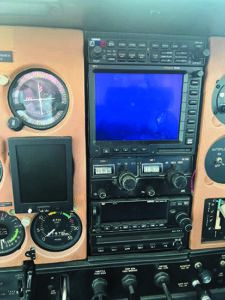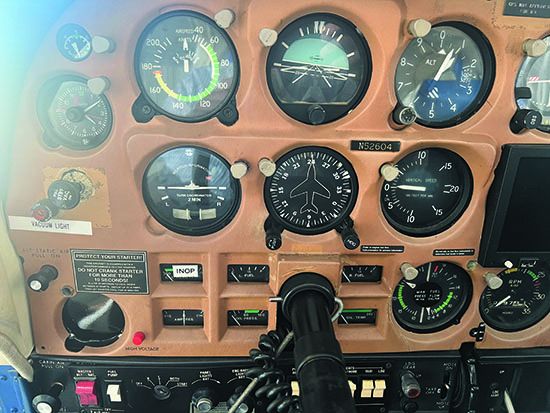To kick off Aviation Consumer’s new Panel Planner 101 feature, reader Marc Harding sent a few panel pics of his 1977 Cessna 177RG Cardinal. Buying the airplane “deaf, dumb and blind,” he says, when it was new back in 1977, it came equipped with a Loran-C system, a Century I wing-leveler autopilot and dual King KX170B radios. The panel underwent a big upgrade in 2000, when he removed a KX170B and replaced it with a Garmin GMA 340 audio panel, a Garmin GNC 300XL GPS/comm, a Garmin-AT MX20 MFD and S-TEC 55X autopilot. It recently had an ADS-B upgrade, but the old King KT76A transponder (it’s on the far right panel, not pictured) remains.
“At 74, I hope to have 10 or 15 years of flying ahead, and I want to be cautious both for me and the plane,” Harding told us. While instrument rated, he says he’s a fair-weather flyer, but wants the capability to handle light IFR, including approaches in IMC. Ridding the vacuum system and spinning iron gyros is part of the plan. Let’s do some ninja planning.
ALL IN BY PULLING IT ALL OUT

The dilemma here is that while most of that gear works, and the obvious plan would be to retain some of it as backup since it was a big investment 22 years ago (a long time in avionics life), only two major components in the suite—the autopilot and JPI engine monitor—have full factory support. Do you keep the GNC 300XL, MX20, GMA 340 and KT76A and gamble that they’ll keep working, or ditch them while the panel is opened up for the upgrade?
A quick-hit upgrade is to remove the vacuum system, AI and DG and replace the instruments with Garmin’s GI 275 electronic flight instruments—one for attitude and the other for electronic HSI—interfaced with the S-TEC for heading command and nav tracking. Aspen’s Evolution Max PFD is an alternative instrument upgrade, and so is the uAvionix AV-30C, but the AV-30C doesn’t have vertical GPS guidance for flying approaches or autopilot interface.
Over in the stack, remove the KX170B and CDI and replace it with a Garmin GNC 355 GPS/comm. The equipment alone is $16,400. This is a no-cut install—the GI 275s fit in the existing holes, and the stack work is easy. Out the door, it’s likely a $20,000 upgrade, plus the cost to replace incidentals like old antennas and circuit breakers and clean up old wiring.
One all-in approach is to remove everything in the stack (except the autopilot) and replace the audio panel with PS Engineering’s slide-in PMA450C, a Garmin GNC 355, a standalone comm radio (Trig’s TY96A is one choice) and a Mode C transponder, maybe Garmin’s GTX 325. Since Harding flies with an iPad, the Garmin Flight Stream built into the GNC 355 can feed nav data to the Garmin Pilot or ForeFlight Mobile apps. For ADS-B traffic and weather, go with a portable receiver. This kicks the equipment cost we’ll north of $23,000, which can yield a $30,000 project, but should be good for the long haul, which hopefully is 10 years, at least. Harding’s favorite shop told him it would be a year before they can do the project.
Got a panel for brainstorming? Send us your best images and describe your goals and we’ll get you educated to start talking with an avionics installer for quotes.





